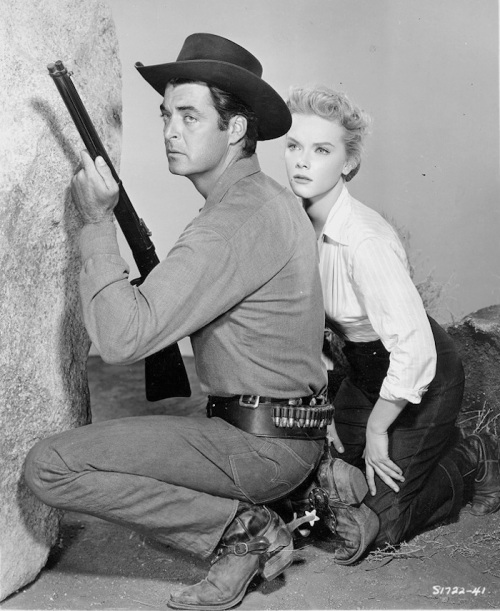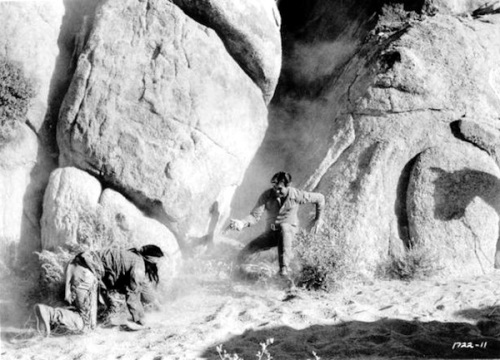
Produced and Directed by Allen H. Miner
Written by Leo Gordon
Director of Photography: Edward Colman, ASC
Film Editors: Jerry Young and John H. Post
Music by Jerry Goldsmith
Cast: George Montgomery (Marshal Clay Morgan), Diane Brewster (Helen Danner), Tom Pittman (Flytrap), Leo Gordon (Hank Danner), House Peters Jr. (Holman), George Trevino (Pedoline), Lynn Cartwright (Kitty), Strother Martin (Petey Walker), Sebastian Cabot (Frenchy), Dan Blocker, John Mitchum, Hope Summers
__________
Black Patch (1957) is an odd little George Montgomery picture from his own Montgomery Productions, Inc., written by Leo Gordon. While it dishes up plenty of the elements we know and love in these films, it’s so offbeat that opinions about it are all over the place — even among diehard Montgomery fans.
Over the course of his career, character actor Leo Gordon made a name for himself as a writer, scripting everything from horror pictures like Attack Of The Giant Leeches (1959) to the war movie Tobruk (1967) to episodes of Adam-12. His first script was this one.
Leo Gordon: “When Charles Marquis Warren was directing the pilot for Gunsmoke, I told him I had an idea for an episode. ‘Don’t tell me, write it,’ he answered. I went home and the next thing I knew, I had 110 pages. I showed it to my agent. Next thing I know, George Montgomery wanted to buy it. That was Black Patch.”* 
Clay Morgan (Montgomery) is the marshal of Santa Rita, New Mexico. Having lost an eye in the Civil War, he’s known as “Black Patch.” (GM looks so cool in that big black hat and eyepatch!) An old friend, Hank Danner (Gordon), arrives in town with his wife, Helen (Diane Brewster). Helen and Morgan had been deeply in love (still are), but when he never returned from the war, she married Hank. Then, as fate would have it, Morgan has to arrest Hank for bank robbery.

From there, things go downhill. Not just for our characters, but with the movie itself. As Hank sits in jail, Black Patch becomes more and more concerned with unappealing minor characters (Tom Pittman and Sebastian Cabot, to name just two) and Montgomery disappears for a substantial amount of screen time. There are some interesting scenes in there, for sure, but the shift in tone is quick and jarring. It’s almost like the first half of one movie was spliced onto the second half of another. What makes this so frustrating is that the first half is so good. Montgomery and Gordon are at the top of their game, and the scenes between Montgomery and Diane Brewster are really well done. Things manage to get back on track towards the end, but it’s a bit too late.

But there’s still plenty to like about Black Patch. Director of photography Edward Colman, from Jack Webb’s Dragnet team, was brought in. (The first Dragnet series had just wrapped up its run.) During production, Montgomery told Erskine Johnson, “Films owe TV an Oscar for getting us off our self-satisfied — er, uh, couches — and into speedy, bang-up production.” Regardless of how many setups he was getting in each day, Colman’s camerawork is inventive and appropriately moody, with the same flair he displayed on the 1954 Dragnet feature. Colman would spend the latter part of his career shooting Disney movies such as The Absent-Minded Professor (1961), Mary Poppins (1964) and The Love Bug (1968, his last credit).
Producer/director Allen H. Miner had a long career in television. This was an early feature for him. He directed another Western the same year, The Ride Back (1957) — a cool little movie starring Anthony Quinn and William Conrad. Miner’s direction is solid in Black Patch, for the most part, but I wish he’d kept the story from drifting off course.
Gene Autry’s Melody Ranch (the Monogram Ranch renamed after Autry bought it) is used to good effect. Pretty much the entire picture takes place in town, and Colman shoots it very well. Just five years after this film, the ranch would be largely destroyed by fire. While I complained about the shift in focus away from Montgomery, Gordon and Brewster, there are some great character actors to be found here. Sebastian Cabot is really slimy as Frenchie, Strother Martin’s a deputy who witnessed the bank robbery, and Leo Gordon’s wife Lynn Cartwright is Kitty, a saloon girl. What’s more, Dan Blocker (a couple years away from Bonanza), John Mitchum (Robert’s brother) and Hope Summers (Clara Edwards from The Andy Griffith Show) turn up without credit, though they all have speaking parts.

Along with this being Leo Gordon’s first script, Black Patch was the first film scored by the great Jerry Goldsmith. The music’s excellent and immediately recognizable as his work — he really hit the ground running. Verna Fields, the masterful film editor of What’s Up, Doc (1972), Jaws (1975, her Oscar-winning work may have saved the movie) and other key films of the 70s, gets an early credit here, as sound editor.
While Black Patch tends to divide people, the DVD from Warner Archive certainly won’t. Not only is a movie that’s been almost impossible to track down now just a click away, it’s beautiful — clean and sharp, with the proper framing and excellent contrast. There are lots of night scenes here, and never does it seem murky or dark. A perfect transfer that does Edward Colman proud. I was also happy to see that Warner Archive made good use of the original artwork. I’ve always loved that poster.
Why not read Laura’s take on Black Patch?
* from an interview with Boyd Magers.
Read Full Post »





















